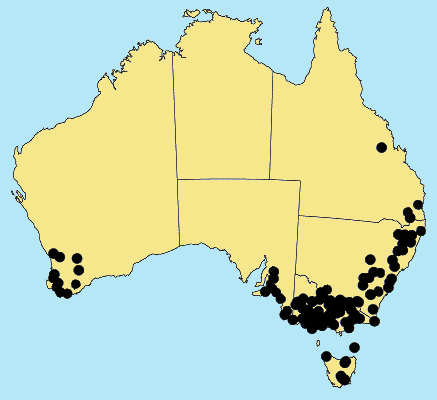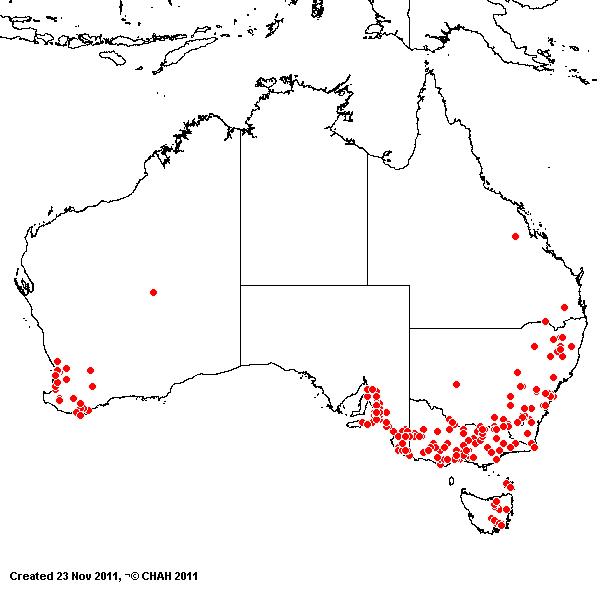Phalaris
aquatica* L. Cent. Pl. 1:
4 (1755). Classification. (GPWG 2001) : Subfamily Pooideae.
Tribe Poeae.
Type of Basionym or
Protologue Information: LT: Hasselquist s.n., Middle East
(LINN-78.4). LT designated by Hubbard, Fl Trop. E. Africa 97 (1970).
Recent synonyms:
P. tuberosa, P. tuberosa var. stenoptera.
Key references
(books and floras): [1952] C.A.Gardner, Flora of Western Australia 1
Gramineae (as P. tuberosa), [2002] D.Sharp & B.K.Simon, AusGrass,
Grasses of Australia, [2002] J.Wheeler, N.Marchant & M.Lewington, Flora
of the South West (427), [2006] J.Jessop, G.R.M.Dashorst, F.M.James, Grasses
of South Australia (239), [2008] S.W.L.Jacobs, R.D.B.Walley &
D.J.B.Wheeler, Grasses of New South Wales (337), [2009] A.Wilson (ed.). Flora
of Australia, Vol 44A. Poaceae 2 (147).
Illustrations:
[1952] C.A.Gardner, Flora of Western Australia 1 Gramineae (24,
Pl.4, as P. tuberosa), [2006] J.Jessop, G.R.M.Dashorst, F.M.James, Grasses
of South Australia (240, Fig. 182),
[1984] N.T.Burbidge. rev. S.W.L.Jacobs, Australian Grasses (209), [2008] S.W.L.Jacobs, R.D.B.Whalley
& D.J.B.Wheeler, Grasses of New South Wales, 4th edn (335), [2009].
A.Wilson (ed.), Flora of Australia 44A: Poaceae 2 (148, Fig.22).
Habit.
Perennial. Rhizomes present, short. Culms 65–150 cm tall, 4–6 -noded. Ligule an
eciliate membrane, entire. Leaf-blades 9.5–35 cm long, 3–15 mm wide.
Inflorescence.
Inflorescence solid, a panicle. Panicle oblong or ovate, 1.5–13.5 cm long,
1–2.5 cm wide.
Spikelets.
Spikelets pedicelled. Fertile spikelets 1 or more flowered, with 1 fertile
floret, comprising 2 basal sterile florets, comprising 1 fertile floret(s),
without rachilla extension, obovate, laterally compressed, 4.3–7.5 mm long.
Glumes. Glumes
similar, thinner than fertile lemma. Lower glume elliptic, chartaceous, keeled,
1-keeled, winged on keel, winged moderately, 3 -nerved. Lower glume apex
muticous. Upper glume elliptic, 4.5–7.5 mm long, chartaceous, keeled, 1-keeled,
winged on keel, 3 -nerved. Florets. Basal sterile florets 2 or more,
barren, without significant palea. Lemma of lower sterile floret indurate.
Lemma of upper sterile floret 0.2–2.2 mm long.
Fertile lemma 2.8–4.5
mm long, keeled, 5 -nerved. Lemma surface indumented. Palea 2 -nerved, without
keels. Anthers 3. Grain 2.2–2.5 mm long.
Continental
Distribution: Europe, Africa, Temperate Asia, Tropical Asia, Australasia,
Pacific, and South America.
Australian Distribution:
Western Australia, South Australia, Queensland, New South Wales, Victoria,
Tasmania, Lord Howe.
Western Australia:
Drummond. South Australia: Northern Lofty, Murray, Southern Lofty,
Kangaroo Island, South-eastern. Queensland: Leichhardt, Darling Downs. New
South Wales: North Coast, Central Coast, South Coast, Northern Tablelands,
Central Tablelands, Southern Tablelands, Central-Western Slopes, South-Western
Slopes. Victoria: East Gippsland, Eastern Highlands, Gippsland
Highlands, Gippsland Plain, Grampians, Lowan Mallee, Midlands, Murray Mallee,
Otway Plain, Otway Range, Riverina, Volcanic Plain, Wannon, Wimmera.
Notes.
Grown as a pasture grass, extensively cultivated on the N.S.W. tablelands.
Introduced.
Occurring in all states, but not N.T., also on Lord Howe Is. Native to the
Mediterranean. Often along river and creek banks, in some areas on roadsides
and waste areas. Flowers (July-)Oct.-May. Fruits Jan.-Mar.


